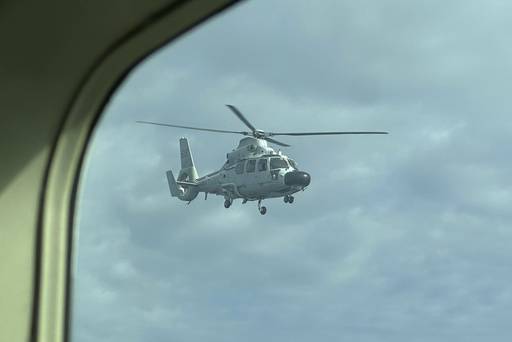PH to protest China moves vs BFAR plane

The Philippines will not be deterred by the “unprofessional and reckless flight maneuvers” of a Chinese military helicopter that hovered dangerously close to an aircraft of the Bureau of Fisheries and Aquatic Resources (BFAR) during a routine maritime domain awareness flight over the West Philippine Sea.
This was disclosed after the National Maritime Council (NMC) said it was “deeply disturbed” by the dangerous maneuvers of a People’s Liberation Army (PLA) Navy Harbin Z-9 helicopter with tail number 68 that flew as close as 3 meters above the BFAR’s Cessna 208B Grand Caravan EX aircraft.
In a statement on Tuesday night, the NMC said the Philippines will file a formal diplomatic protest against China over the “grave incident” that endangered the lives of the pilots and journalists aboard the BFAR Cessna aircraft.
It added that the country has “undeniable sovereignty and jurisdiction over Bajo de Masinloc,” where China’s latest aggression took place.
“China’s illegal, coercive and aggressive behavior will not deter the Philippines from continuing the conduct of its routine maritime operations in accordance with its sovereignty over the shoal,” the NMC said.
It added that the country will “not waver in its duty to safeguard its maritime interests over the shoal in accordance with Republic Act [No.] 12064 or the Philippine Maritime Zones Act and international law, particularly Unclos and the 2016 South China Sea arbitral award.”
Irresponsible action
The NMC stressed that the Philippines is “committed to the rule of law and will always uphold international law,” as it called on China to do the same.
“We urge China to respect international law, engage in responsible state behavior, pursue peaceful settlement of disputes and refrain from actions that undermine regional peace and stability,” it said.
The BFAR aircraft was on a routine maritime domain awareness flight over Bajo de Masinloc on Tuesday morning when the PLA Navy helicopter flew too close above it.
Bajo de Masinloc is within the country’s 370-kilometer exclusive economic zone (EEZ) in the West Philippine Sea.
Journalists aboard the BFAR Cessna aircraft, including an Inquirer reporter, witnessed the Chinese military helicopter issuing a radio challenge to the BFAR aircraft to leave the airspace immediately.
The Chinese military helicopter repeatedly flew too close to the Cessna airplane, hovering as close as 3 meters above the BFAR aircraft.
Following the incident, the Philippine Coast Guard slammed China’s dangerous maneuvers as “blatant disregard for the International Civil Aviation Organization’s international aviation regulations.”
The NMC agreed that the “blatantly hazardous action endangered the safety of the pilots and passengers onboard.”
“It demonstrated a lack of regard for internationally accepted norms on good airmanship and flight safety,” it said.
United States Ambassador to the Philippines MaryKay Carlson on Wednesday also “condemned” the latest dangerous maneuvers taken by a Chinese PLA aircraft against the Philippine chopper over Panatag (Scarborough) Shoal.
“We condemn the dangerous maneuvers by a PLA Navy helicopter that endangered pilots and passengers on a Philippine air mission,” Carlson said in a post on X.
“We call on China to refrain from coercive actions and settle its disputes peacefully in accordance with international law,” Carlson said.
While the Chinese Embassy in Manila has yet to respond to the Inquirer’s request for comment on Carlson’s statement, the PLA Southern Theater Command (STC) on Tuesday issued a statement about the incident saying it was Manila that “illegally trespassed.”
The STC blamed Manila’s chopper for entering Huangyan Island, China’s name for Panatag, airspace “without the permission of the Chinese government.”
“Then confused right and wrong and spread false narratives,” STC spokesperson Tian Junli said.
“The PLA Southern Theater Command organized naval and air forces and tracked, monitored, warned and expelled it in accordance with laws and regulations,” Tian said.
China claims practically all of the South China Sea, including the West Philippine Sea.
But the 2016 arbitral award reaffirmed the Philippines’ 370-km EEZ in the western region and rejected China’s claim for having “no legal basis” under international law.

















